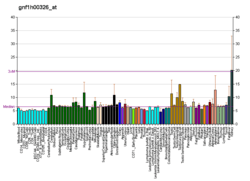HOXD8
Homeobox protein Hox-D8 is a protein that in humans is encoded by the HOXD8 gene.[5][6][7]
This gene belongs to the homeobox family of genes. The homeobox genes encode a highly conserved family of transcription factors that play an important role in morphogenesis in all multicellular organisms. Mammals possess four similar homeobox gene clusters, HOXA, HOXB, HOXC and HOXD, located on different chromosomes, consisting of 9 to 11 genes arranged in tandem. This gene is one of several homeobox HOXD genes located in a cluster on chromosome 2. Deletions that remove the entire HOXD gene cluster or the 5' end of this cluster have been associated with severe limb and genital abnormalities. In addition to effects during embryogenesis, this particular gene may also play a role in adult urogenital tract function.[7]
References
- 1 2 3 GRCh38: Ensembl release 89: ENSG00000175879 - Ensembl, May 2017
- 1 2 3 GRCm38: Ensembl release 89: ENSMUSG00000027102 - Ensembl, May 2017
- ↑ "Human PubMed Reference:".
- ↑ "Mouse PubMed Reference:".
- ↑ McAlpine PJ, Shows TB (Aug 1990). "Nomenclature for human homeobox genes". Genomics. 7 (3): 460. doi:10.1016/0888-7543(90)90186-X. PMID 1973146.
- ↑ Scott MP (Dec 1992). "Vertebrate homeobox gene nomenclature". Cell. 71 (4): 551–3. doi:10.1016/0092-8674(92)90588-4. PMID 1358459.
- 1 2 "Entrez Gene: HOXD8 homeobox D8".
Further reading
- Goodman FR (2003). "Limb malformations and the human HOX genes". Am. J. Med. Genet. 112 (3): 256–65. doi:10.1002/ajmg.10776. PMID 12357469.
- Redline RW, Williams AJ, Patterson P, Collins T (1992). "Human HOX4E: a gene strongly expressed in the adult male and female urogenital tracts". Genomics. 13 (2): 425–30. doi:10.1016/0888-7543(92)90263-R. PMID 1351871.
- Oliver G, Sidell N, Fiske W, et al. (1989). "Complementary homeo protein gradients in developing limb buds". Genes Dev. 3 (5): 641–50. doi:10.1101/gad.3.5.641. PMID 2568311.
- Manohar CF, Salwen HR, Furtado MR, Cohn SL (1996). "Up-regulation of HOXC6, HOXD1, and HOXD8 homeobox gene expression in human neuroblastoma cells following chemical induction of differentiation". Tumour Biol. 17 (1): 34–47. doi:10.1159/000217965. PMID 7501971.
- Guazzi S, Lonigro R, Pintonello L, et al. (1994). "The thyroid transcription factor-1 gene is a candidate target for regulation by Hox proteins". EMBO J. 13 (14): 3339–47. PMC 395231. PMID 7913891.
- Rosen DR, Brown RH (1993). "Dinucleotide repeat polymorphism in the HOX4E locus". Hum. Mol. Genet. 2 (5): 617. doi:10.1093/hmg/2.5.617. PMID 8100165.
- Del Campo M, Jones MC, Veraksa AN, et al. (1999). "Monodactylous limbs and abnormal genitalia are associated with hemizygosity for the human 2q31 region that includes the HOXD cluster". Am. J. Hum. Genet. 65 (1): 104–10. doi:10.1086/302467. PMC 1378080. PMID 10364522.
- Limongi MZ, Pelliccia F, Gaddini L, Rocchi A (2000). "Clustering of two fragile sites and seven homeobox genes in human chromosome region 2q31→q32.1". Cytogenet. Cell Genet. 90 (1–2): 151–3. doi:10.1159/000015651. PMID 11060466.
- Kosaki K, Kosaki R, Suzuki T, et al. (2002). "Complete mutation analysis panel of the 39 human HOX genes". Teratology. 65 (2): 50–62. doi:10.1002/tera.10009. PMID 11857506.
- Strausberg RL, Feingold EA, Grouse LH, et al. (2003). "Generation and initial analysis of more than 15,000 full-length human and mouse cDNA sequences". Proc. Natl. Acad. Sci. U.S.A. 99 (26): 16899–903. doi:10.1073/pnas.242603899. PMC 139241. PMID 12477932.
External links
- HOXD8+protein,+human at the US National Library of Medicine Medical Subject Headings (MeSH)
This article incorporates text from the United States National Library of Medicine, which is in the public domain.




